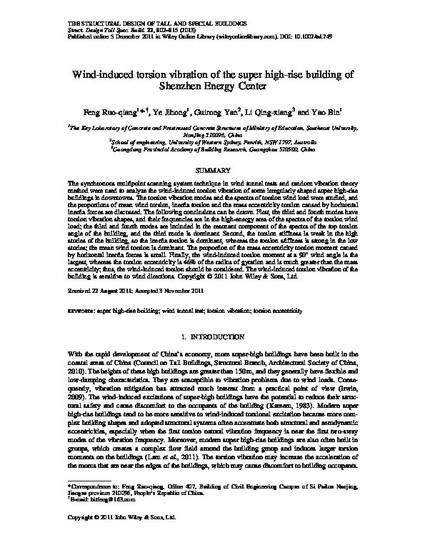
The Synchronous Multipoint Scanning System Technique in Wind Tunnel Tests and Random Vibration Theory Method Were Used to Analyze the Wind-Induced Torsion Vibration of Some Irregularly Shaped Super High-Rise Buildings in Downtowns. the Torsion Vibration Modes and the Spectra of Torsion Wind Load Were Studied, and the Proportions of Mean Wind Torsion, Inertia Torsion and the Mass Eccentricity Torsion Caused by Horizontal Inertia Forces Are Discussed. the Following Conclusions Can Be Drawn. First, the Third and Fourth Modes Have Torsion Vibration Shapes, and their Frequencies Are in the High-Energy Area of the Spectra of the Torsion Wind Load; the Third and Fourth Modes Are Included in the Resonant Component of the Spectra of the Top Torsion Angle of the Building, and the Third Mode is Dominant. Second, the Torsion Stiffness is Weak in the High Stories of the Building, So the Inertia Torsion is Dominant, Whereas the Torsion Stiffness is Strong in the Low Stories; the Mean Wind Torsion is Dominant. the Proportion of the Mass Eccentricity Torsion Moment Caused by Horizontal Inertia Forces is Small. Finally, the Wind-Induced Torsion Moment at a 90° Wind Angle is the Largest, Whereas the Torsion Eccentricity is 46% of the Radius of Gyration and is Much Greater Than the Mass Eccentricity; Thus, the Wind-Induced Torsion Should Be Considered. the Wind-Induced Torsion Vibration of the Building is Sensitive to Wind Directions. Copyright © 2011 John Wiley & Sons, Ltd. Copyright © 2011 John Wiley & Sons, Ltd.
- super high-rise building,
- torsion eccentricity,
- torsion vibration,
- wind tunnel test
Available at: http://works.bepress.com/guirong-yan/80/

National Natural Science Foundation of China Institutions, Grant 50908044